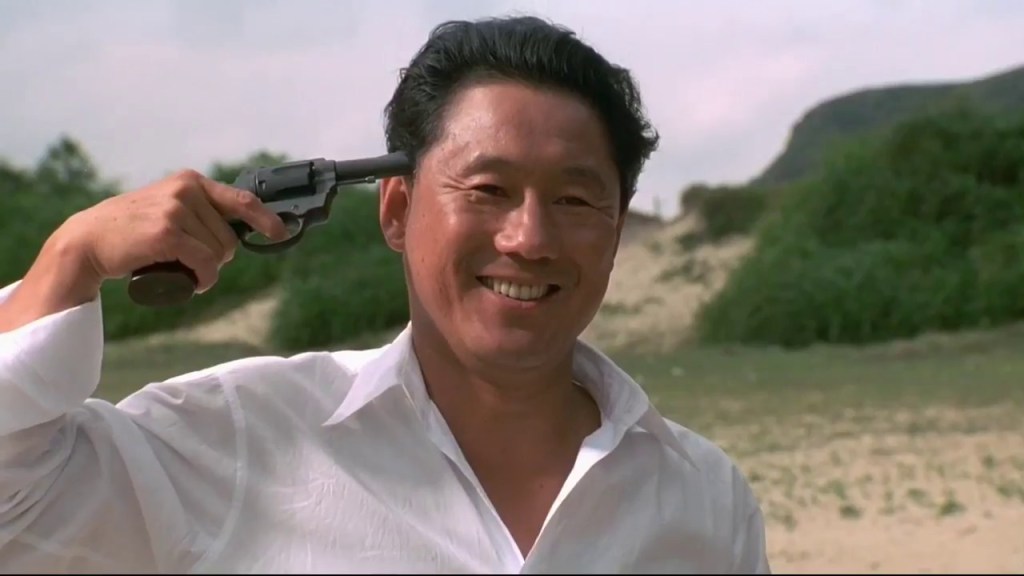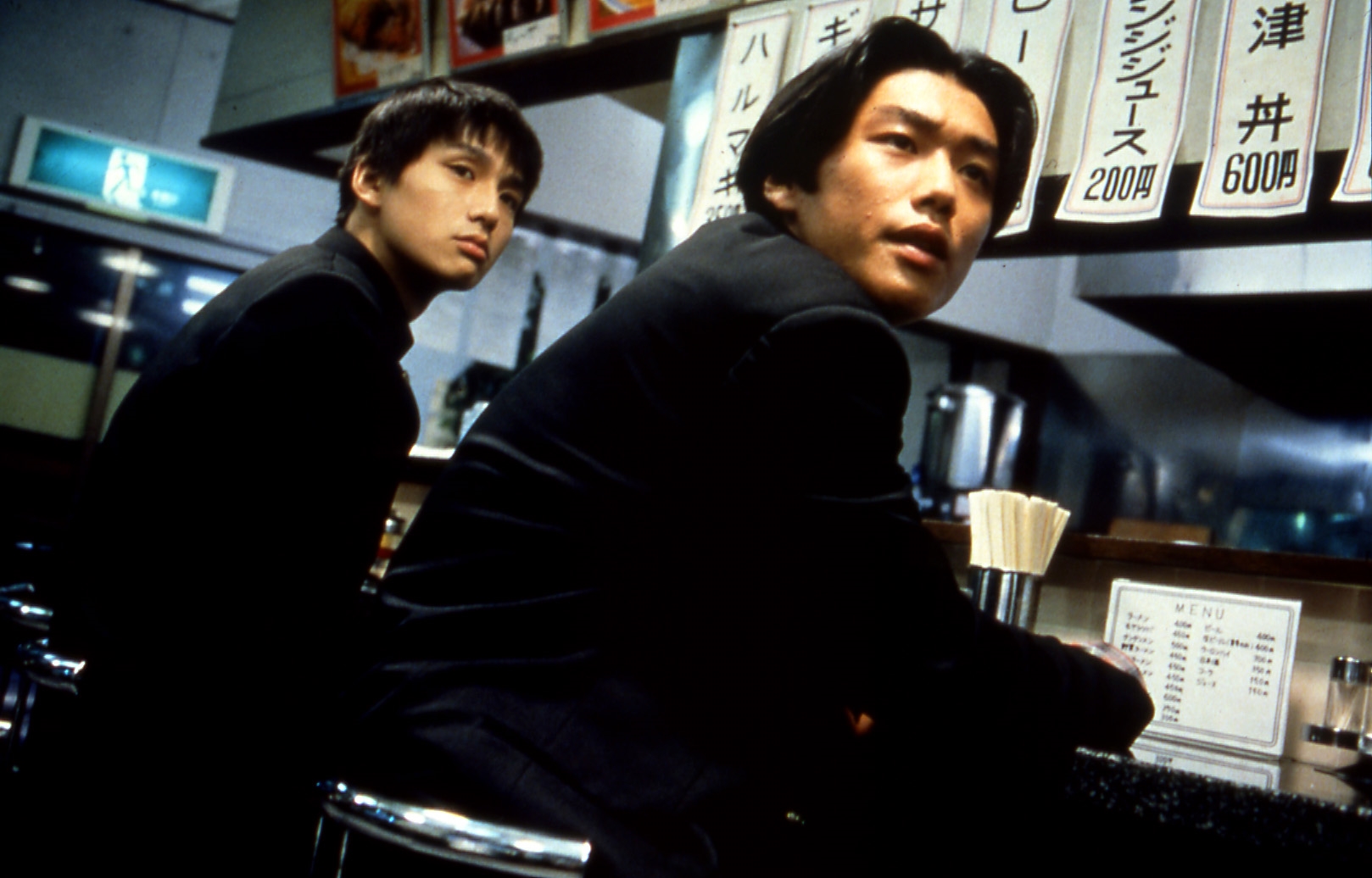Takeshi Kitano, often known simply as “Beat Takeshi”, is a multifaceted Japanese artist and filmmaker who has left an indelible mark on the international film industry. Best known for films like Hana-bi and Sonatine, Kitano’s unique blend of dry humour and stark violence has earned him critical acclaim and a distinctive place in contemporary cinema.
Kitano’s films often explore the complex dynamics of masculinity, loneliness, and violence, particularly within the context of the Japanese yakuza. His characters are typically stoic and introspective, with a tendency towards abrupt and brutal violence. A recurring theme in his work is the existential struggle and moral ambiguity, often portrayed through the lives of gangsters, cops, and ordinary individuals caught in extraordinary circumstances. Kitano’s approach to storytelling is largely minimalist, focusing on visual narrative and minimal dialogue, which adds to the poetic quality of his films.
Visually, Kitano’s style is marked by its simplicity and elegance. His films often feature long, static shots and meticulously composed frames, creating a distinctive aesthetic that is both serene and unsettling. Though graphic, the violence in his films is often depicted in a stylised, almost surreal manner, contrasting sharply with the otherwise calm visual narrative. Kitano’s approach to cinema also embraces the unpredictability of life, often expressed through unexpected bursts of violence or humour, disrupting the tranquillity of the scene.
Takeshi Kitano’s unique blend of humour, violence, and existential contemplation, has inspired a new wave of filmmakers and has established him as one of the most influential directors in modern Japanese cinema. His works often defy traditional genre conventions, offering an alternative, more contemplative approach to storytelling.

Takeshi Kitano (1947 – -)
Calculated Films:
- A Scene at the Sea (1991)
- Sonatine (1993)
- Kids Return (1996)
- Hana-Bi (1997)
- Kikujiro (1999)
- Dolls (2002)
Similar Filmmakers



Takeshi Kitano’s Top 10 Films Ranked
1. Hana-Bi (1997)
Genre: Crime, Drama, Psychological Drama

2. Sonatine (1993)
Genre: Yakuza eiga, Drama, Black Comedy

3. Kikujiro (1999)
Genre: Road Movie, Comedy, Drama, Buddy

4. A Scene At The Sea (1991)
Genre: Sports, Drama, Romance, Slice of Life

5. Kids Return (1996)
Genre: Coming-of-Age, Drama, Sports

6. Dolls (2002)
Genre: Romance, Drama, Hyperlink Cinema

7. Violent Cop (1989)
Genre: Crime, Police Procedural, Thriller

8. Zatoichi (2003)
Genre: Chambara, Jidaigeki

9. Brother (2000)
Genre: Gangster Film, Yakuza eiga, Drama

10. Achilles and the Tortoise (2008)
Genre: Drama

Takeshi Kitano: Themes and Style
Themes:
- Violence and Brutality: One of Kitano’s most evident themes, violence in his films isn’t simply for shock value. It’s often sudden, unglamorous, and has lasting consequences, serving to highlight the fragility of life.
- Honour and Yakuza Codes: Films like Sonatine and Hana-bi delve into the complex world of the Yakuza (Japanese organised crime), illuminating themes of integrity, loyalty, and the consequences of living outside societal norms.
- Loneliness and Alienation: Many of Kitano’s characters grapple with feelings of isolation, whether self-imposed or due to external circumstances.
- Masculinity and Vulnerability: His male protagonists, often stoic on the surface, showcase a vulnerability and depth beneath their rugged exteriors, challenging conventional representations of masculinity.
Styles:
- Minimalistic Dialogue: Kitano often employs sparse dialogue, allowing silence and the unspoken to convey emotions and narrative weight.
- Static Shots: A hallmark of his cinematographic style, Kitano’s static shots invite audiences to be more observant and draw their own interpretations.
- Juxtaposition of Violence and Calm: Many scenes transition abruptly from tranquil moments to violent outbursts, creating a palpable tension.
- Nature and Landscapes: The serene backdrop of beaches, mountains, and natural scenery contrasts with the turmoil experienced by his characters.
Directorial Signature:
- Painterly Composition: As a painter himself, Kitano’s shots are often composed with meticulous and aesthetic precision, reminiscent of canvases that tell stories.
- Deadpan Humor: Stemming from his comedy background, Kitano’s films inject moments of humour, often delivered with a deadpan execution, accentuating the absurdity of life.
- Character Depth: Despite their flaws, Kitano’s characters are humanised, never simply villains or heroes. They embody a blend of weaknesses, desires, regrets, and moments of kindness.
- Emotionally Charged Music: The musical choices in his films, often working with composer Joe Hisaishi, further emphasise the emotional depth and narrative arcs.
Takeshi Kitano: The 249th Greatest Director




